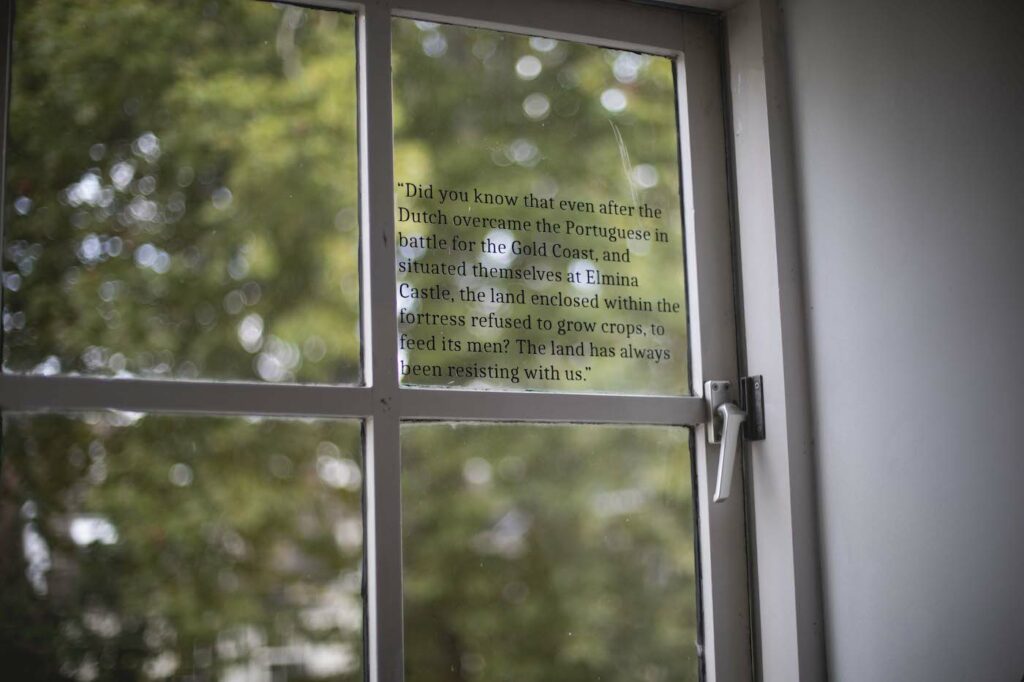Casco Art Institute, Utrecht, Netherlands
14 Sep 2019 - 03 Nov 2019

Ama Josephine Budge, The Waters that Move Within Me (detail), text, audio, rope, tree trunks, paper, 2019. Installation view Het is of de stenen spreken (silence is a commons), Casco Art Institute: Working for the Commons, 2019. Photo: Martha Stroo
If together we talk and separately we understand, what might we understand together if we listen to the stones speak? How do we unlearn to speak for the commons and listen to them instead? And how can we protect language commons that are of neither power nor capital?
The Autumn 2019 exhibition program at Casco Art Institute presents Het is of de stenen spreken (silence is a commons), featuring four solo shows of the distinguished artistic practices and languages by Babi Badalov, Ansuya Blom,Ama Josephine Budge, and Mire Lee. Each artist presents forms of communication that transgress the norms and habits shaped by power and capital-driven media.
Misunderstanding, incommunicability, and distressing language are some of the most frequently encountered obstacles in collaboration and sharing practices, even among affinity and coalition groups. These cracks and rough stones are the study of our Autumn exhibition program: the four artists offer insight into expressive ways to communicate when verging on failure to do so. Their works take up the possibilities and limitations of language, as a departure point or reconciliation, in performative and material ways. The result is an affective resource of new vocabularies, syntax, and stories that break the tensions around ideas of simple understanding.
Babi Badalov offers us a jumble of words fetched and twisted across mother tongues drawn on second hand t-shirts, papers, or walls. “Immigration becomes yougration becomes hegration.” We can follow the words that crawl away from correctness to celebrate and harness mistakes as the source for new images, words, and meanings, while creating the heterogeneous cultural landscapes in which artists live and travel through.
Ansuya Blom invites us to sense a dreamworld or a dark corner of the mind through her delicately rendered paintings, drawings, collages, sculpture, and films. Revealed vital organs in a series of paintings refer to the consequences of putting words to what you cannot describe yet what’s happening irresistibly on your “insides.” The partially concealed interior scenes of psychiatry clinics on collages draw a hazy line between confusion and clarity.
In her speculative fiction, Ama Josephine Budge pictures landscapes whereby enhanced, human-hybrid and often queer protagonists have adapted to the melting, polluted planet. War-torn and dry catastrophic sceneries are depicted in which inhabitants, like the flora and fauna, not only remain resilient but are pronounced with ecstatic feeling in their every movement and detail. Words decree that the only future possible is one of queer Black joy and multispecies justice.
We see objects reluctantly moving in Mire Lee’s sculptural work. They look like human bodies or mobs, abandoned and struggling to move, and express their abject existence in spite of themselves. They counter the worlds of words, inviting them to face their hypocrisy: plastic tubes adhered to a small motor slap like the habitual eloquence of speech, slowly moving and getting stuck in the glistening wetness of glycerin.
In the Netherlands, one cannot turn a corner without encountering Dutch spreekwoorden en gezegden (proverbs and sayings), pithy expressions stating wisdom to be true by the majority. The exhibition title, Het is of de stenen spreken, is borrowed from a less common expression that refers to unexpected information that surfaces as if by miracle. “Silence is a commons,” the title of an inspiring address on contemporary communication given by philosopher Ivan Illich in 1982 (available online), is included in the exhibition title not in direct translation of Het is of de stenen spreken but to complement it. Nearly 40 years ago, Illich talked about how, like other commons, the commons of language has increasingly become enclosed and made vulnerable by machine-based communication. Fast-forward to now, and our current moment shows how information is manipulated for political gain – take for example hate speech, fake news, and algorithms – translated yet dulled by the dominance of English, and standardized but stumbling or indifferent to culturally situated knowledges, notwithstanding the nonhuman languages that other species may speak. (silence is a commons) is to offer a context in which we try to communicate with this exhibition.
While considering a number of the study lines at Casco Art Institute, the exhibition program is conceived around Language & Dissemination, which is one of several study lines on art and the commons.
In much resonance with our colleague-curator Sepake Angiama’s reading of the Ivan Illich text and artists from the 16 Beaver Group’s recent message to mourn together a death of their colleague.